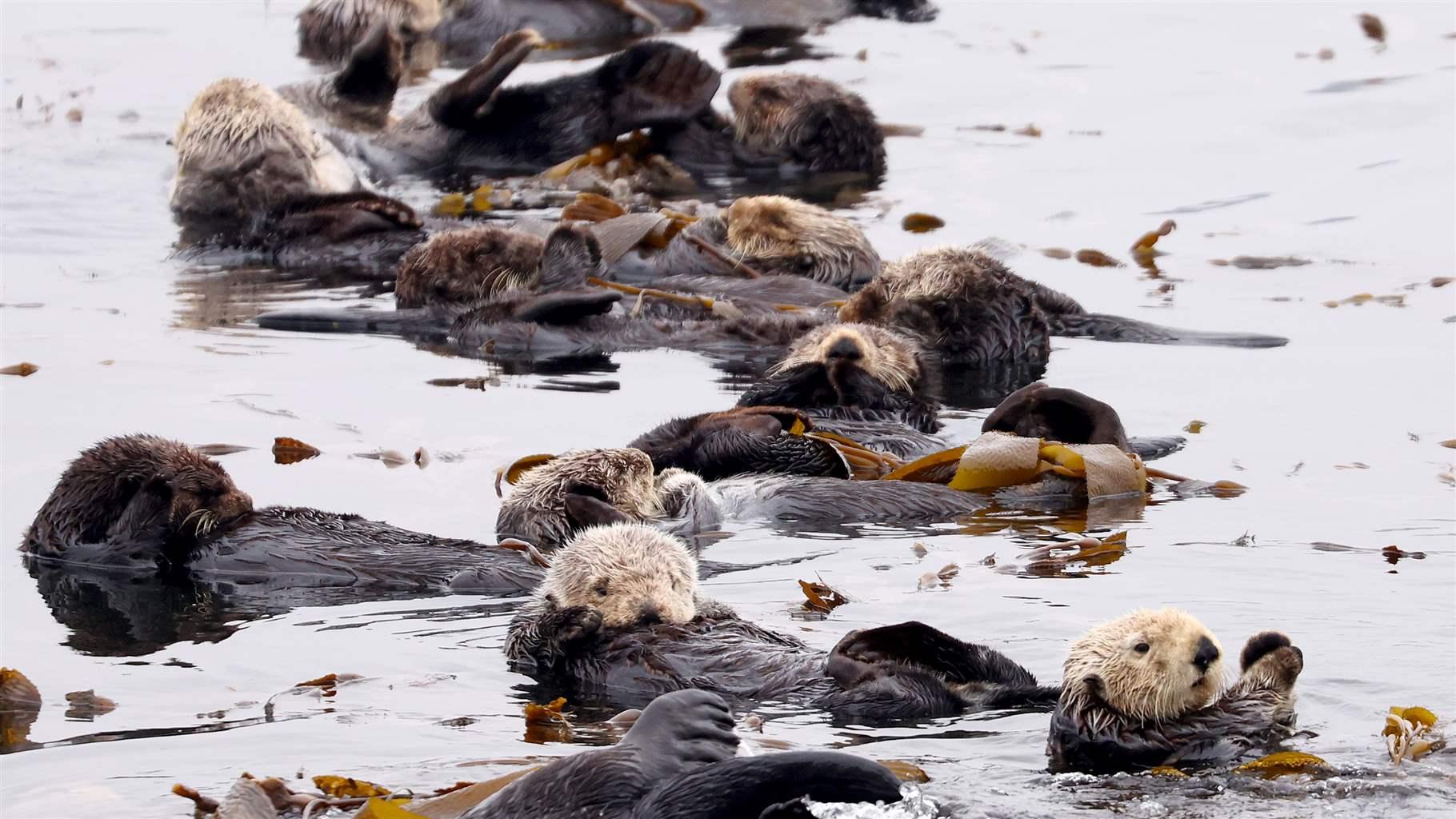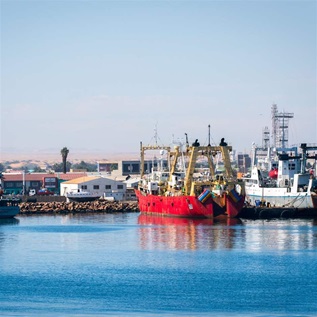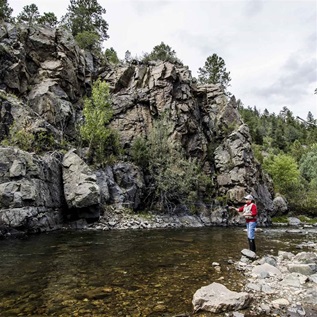Indigenous Governance Principles Can Guide More Equitable Conservation
Sea otter recovery in Pacific Northwest offers lessons for biodiversity protection and management

Biodiversity loss is one of the world’s most urgent environmental challenges, and experts must look beyond Western science to solve the mounting crisis, according to a recent opinion piece in the journal Philosophical Transactions of the Royal Society B. Authored by a team of prominent Indigenous leaders from the Xaayda (Haida), nuučaan̓uł (Nuu-chah-nulth), and Haíɫzaqv (Heiltsuk) Nations, including Haida scholar and Matriarch Kii’iljuus Barbara Wilson; hii-ni-nah-sim, a hereditary leader of the Huu-ay-aht First Nations; and Pew marine fellows Dan K. Okamoto and Anne K. Salomon, the paper argues that Indigenous governance principles, rooted in millennia of reciprocal relationships between people and place, can inform a more equitable way forward for biodiversity conservation.
The authors present governance principles from 17 Indigenous Nations from the northwest coast of North America to explore how Indigenous values and laws can inform more equitable and effective conservation decision-making. They write that contemporary, Western biodiversity sciences grew out of a relationship with the environment that focused on extraction and industrial exploitation—and that regarded nonhuman species as natural resources. These sciences thus tend to serve a narrow set of goals and interests. And although those sciences can play a key role in conservation policy, decision-makers should also rely on Indigenous communities and their knowledge to ensure the broadest possible participation in and benefits from research and conservation.
Indigenous governance principles—including Tll’yahda (making things right), tllgaay (the responsibility of hereditary leaders), yahguudang (respect), and tllxanda (to take care of)—“have been used by our people for millennia to make decisions based on our extensive and complex relationships with all the human and nonhuman beings that share our lands, waters, and skies,” said hii-ni-nah-sim, whose name in English is Tommy Happynook. “It is important that our principles be understood and implemented more broadly because we carry extensive knowledge ... in a much larger context of relational connections to the natural world.”
Lessons from sea otter recovery
For at least 10,000 years, Indigenous peoples along the northwest coast of North America have hunted and traded sea otters through localized practices that took care to maintain the surrounding ecosystem. In the 18th and 19th centuries, however, the maritime fur trade led to the elimination of sea otters from much of the northeast Pacific. As sea otters are a keystone predator—a species that has a large impact on the structure and functioning of its ecosystem—the drastic drop in their numbers had severe environmental ramifications. Sea otters eat shellfish, and their removal from rocky reef ecosystems can allow the rapid proliferation of sea urchins, which decimate kelp forest habitats. On the other hand, high numbers of otters can greatly reduce shellfish populations that are important to the food security, livelihoods, and cultural identity of local peoples.
By the 1960s, sea otters were nearly extinct in the region and might never have recovered if the U.S. government hadn’t planned to test an atomic bomb that same decade on Alaska’s Aleutian Islands, home to one of the last sea otter populations on the West Coast. Before testing the bomb, government officials decided to relocate the otters to areas in California, Oregon, Vancouver Island, and southeast Alaska to spare the animals from the nuclear blast. The relocation sparked a recovery that continues to this day but in some places eliminated the Indigenous shellfish fishery.
The case of sea otter recovery highlights differences between Western and Indigenous approaches to conservation. The former tends “to focus on species-specific biomass or abundance targets and a narrow set of objectives based on unstated values, rarely considering the dynamic and often positive relationships between people, and other components of nature,” Salomon told Pew. While the latter seeks to “sustain reciprocal, long-term relationships among people and other components of nature.”
Through these two lenses, the sea otter narrative can be seen as both a conservation success story and an example of a policy failure that has imposed severe inequities among coastal communities, the authors write. At the time of the otter relocation, Okamoto said in an interview with Pew, government officials did not seem to consider the connections between sea otters, their surrounding habitats, and the shellfish that local communities relied on.
“There's a lack of respect for the people and the ecosystems that are connected to these predators,” he added. “If you’re thinking about an approach of how connected things are and the values of the people that rely on the ecosystems that have developed in absence of sea otters, [you can] avoid some of the conflict by managing things in a more integrative sense, rather than one that's siloed.”
Putting Indigenous principles into practice
When it comes to the case of sea otter recovery, researchers and managers can apply Indigenous governance principles to undo mistakes that led to biodiversity loss and continue to harm Indigenous societies. In practice, this means designing protections that can support a mix of habitat patches—some dominated by otters and kelp and others dominated by shellfish, including sea urchins, clams, crab, and abalone—to benefit both otters and people. These managed habitat mosaics “may have been one mechanism by which humans and sea otters coexisted for millennia,” the authors write, and “can enable sea otter and human coexistence again today.”
Policymakers, rights holders, and stakeholders can also develop new, innovative shared governance structures based on the recognition of peoples’ values and objectives. This recognition, which falls under the Indigenous governance principle of tll'yahda, means publicly acknowledging that state and federal management systems have failed to address the rights and historical management practices of Indigenous communities in the development of sea otter protections.
“[It] requires the humility to acknowledge that our people know how to manage the complex relations that exist in our lands, waters, and skies,” said Happynook. “We might have your answers already, or be able to help craft the questions that need to be asked.”
Okamoto agreed, adding that Indigenous communities should be treated not just as entities to be respected, but as experienced partners in biodiversity and sustainability decision-making.
“It's a broad challenge that we have to grapple with as scientists and conservation practitioners,” he said, “when we think about the impacts of our work on a variety of people and ecosystems.”
Views expressed in the opinion piece are those of the authors and do not necessarily reflect the views of The Pew Charitable Trusts. The authors include Anne K. Salomon, Dan K. Okamoto, Kii'iljuus Barbara J. Wilson, hiininahsim Tommy Happynook, Wickaninnish, wiicuckum Anne Mack, Skil Hiilans Allan Davidson, Gidansda Guujaaw, Wigvilhba Wakas Harvey L. Humchitt, Tom Mexsis Happynook, the late weiwimtaeek Christina Cox, Hyuuštulth Francis Gillette, n'yasim Samantha Christiansen, Dianna Dragon, Hannah M. Kobluk, Lynn C. Lee, M. Tim Tinker, Jennifer J. Silver, Derek Armitage, Iain McKechnie, Aaron MacNeil, Dylan Hillis, Ella-Kari Muhl, Edward J. Gregr, Christian J. C. Commander, and Arianna Augustine.
Nate Fedrizzi works on the Pew Fellows Program in Marine Conservation.










